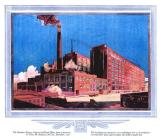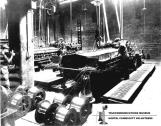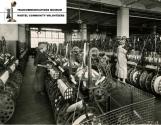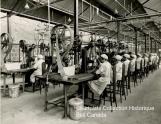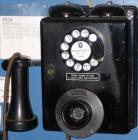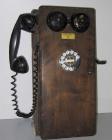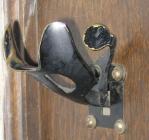2
In 1913 the sod was turned for the building that was to become the largest of its type in the British Empire. It opened in 1915, manufacturing operations from the Imperial Wire & Cable were transfered there following the merger of the two companies. Over a period of years the shops located at the Guy & Notre Dame Streets plant were transferred as well. It was enlarged in 1926, 1929 and 1930 to reach close to a million square feet in floor area.It is made up of six 8 floor sections and 10 one or two floor sections. It was built to last, it rests on 5,151piles and contains 11 million bricks. The only combustible material is the hard wood floor covering. Solid steel fire doors are used to the stairwell entrances, these use 1/4" steel plate reinforced with a 2" angle iron perimeter as well as 3 diagonals. During the Second World War, when it was believed the Nazis would bomb Montreal, evacuation exercises took place, however, only the seventh and eight floors were evacuated because it was felt no bomb would penetrate beyond two floors.
It produced its own power till 1930 with high pressure steam turbines, the steam exhaust was used to heat the building. The building was maintained flawlessly, the author recalls during an early 1970s power failure, the emergency diesel started up in less than 20 seconds to provide emergency power.
It housed a great variety of machinery used to manufacture virtually every single component required to make telephone apparatus and equipment. From the smallest hair thin wire to large power cables nearly six inches thick. Screws of all varieties were machined, metal parts stamped to shape, machined and plated; it had the largest plating shop in Montreal. If a non-standard part was required a drawing was produced and a shop made the part. During the First and Second Wars manufacturing of munitions and essential communications material were produced in huge quantities. It housed over 9,000 employees at its wartime peak in the 1940s.
Shearer was known as the "Motherhouse" because from it came the people that started every subsequent location in Canada and elsewhere. Northern Electric, Northern Telecom and finally Nortel occupied over 50 different buildings in the Montreal area alone.
4
Wire was fabricated following many steps, purchased copper wire about 5/8" thick was cleaned, then run through a series of dies such as these and drawn to the required diameter. Some were further insulated with enamel for magnet wire used in coils for relays, inductors and the like. Others were processed as tinsel wire and insulated for telephone and switchboard cords. Others were insulated with paper, paired and grouped into telephone cables. Larger gauges were used as power cables.6
Here two girls, yes they were frequently referred to as girls in those days rather than women, are shown tending braiders. These weave a textile braid over telephone cords.8
In 1925 machinery such as these drill presses were driven by overhead drive shafts. The motor can be seen on the table in the foreground with its large flat belt, note the absence of safety guards. It is also interesting to observe the "ergonomic" chairs of the day. This photo was taken in one of the single floor sections of the Shearer street plant.10
American undertaker Almon B. Strowger was quite upset with the telephone company. He found out most of his business was going to a competitor because the operator was his competitor's wife. So he decided to invent a system that would do away with operators. He came up with a system, in 1891, where the customer would dial his own number. This required very complex electro-mechanical switches in the telephone office. The first one was installed in LaPorte, Indianna in 1892. He sold his invention, known as Step-by-Step to the Automatic Electric Company.The first Canadian installation was by Automatic Electric in 1901 in Whitehorse, NWT. Northern Electric started manufacturing Step-by-Step automatic switching equipment and dial phones in 1922 using Automatic Electric Dials. The first central office installation was in Winnipeg, Manitoba in 1923. Toronto followed in 1924 with Montreal in 1925.
Customers had to be trained on how to use the phone. They no longer merely had to lift the receiver off the hook. They now had to put their finger in one of the ten holes representing digits 1 to 0, then turn the dial clockwise till the stop, release the dial and wait till it came to rest and repeat for the remaining digits.
12
The wall version of the dial phone although based on the American design differed from it. Northern Electric probably decided it was more economical to adapt an existing phone for dial use rather than use a metal cabinet as Western Electric did in the USA. The first dial wall sets had the dial mounted above the transmitter, but that was quickly changed to the model shown. The wood cabinet is nearly identical to the model 293A Common Battery phone of the early 1900s.Many of the old Common Battery phones were converted to dial use, thereby allowing telephone companies to reuse existing sets rather than junking them. During the Second World War due to a shortage of materials many of these phones, which were then obsolete, were put back into service.
